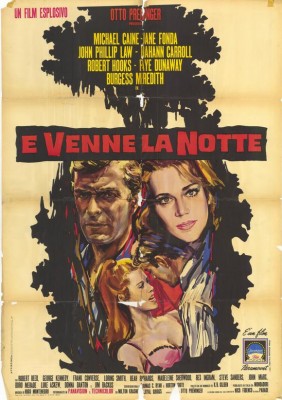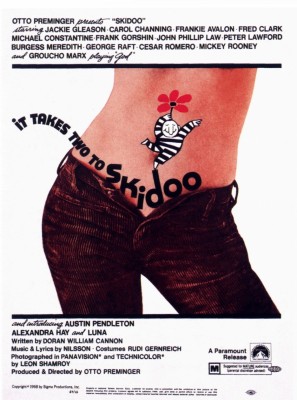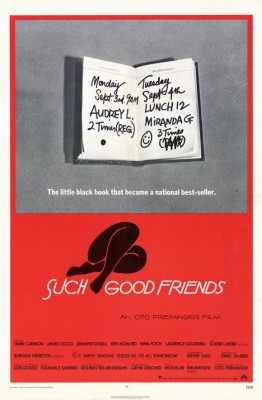| Reviews & Columns |
|
Reviews DVD TV on DVD Blu-ray 4K UHD International DVDs In Theaters Reviews by Studio Video Games Features Collector Series DVDs Easter Egg Database Interviews DVD Talk Radio Feature Articles Columns Anime Talk DVD Savant Horror DVDs The M.O.D. Squad Art House HD Talk Silent DVD
|
DVD Talk Forum |
|
|
| Resources |
|
DVD Price Search Customer Service #'s RCE Info Links |
|
Columns
|
|
|
Otto Preminger Collection (Hurry Sundown / Skidoo / Such Good Friends), The
However, so famously awful are Hurry Sundown and Skidoo those pictures offer a train wreck-like fascination appealing to the more daring/masochistic cineaste. Hurry Sundown (1967) gained some notoriety when it appeared in Harry Medved and Randy Dreyfuss's (and Michael Medved, uncredited) The Fifty Worst Films of All Time, the influential 1978 softcover that helped launch the so-bad-it's-good mode of movie-watching. Upon reflection, the authors would probably like to completely revise. Not only are obvious favorites like Plan 9 from Outer Space omitted, in the case of Hurry Sundown it's not even Preminger's worst film. No, Skidoo is more worthy of that "honor," partly because it's much more entertainingly bad than Hurry Sundown, but also because it's so bizarrely misguided and incoherent, while Hurry Sundown is merely tasteless, overwrought, miscast, wildly inauthentic, and overrun with stereotypes of the American South. As one critic put it, the bottom of the cracker barrel.
The Blu-ray set is compact (about 1 ½ times as thick as a single-disc case), with far more attractive packaging than the DVD versions of these films and, most importantly, the transfers are marked improvement over their standard-def counterparts. If you already own at least two of the three films you're probably best off sticking with the DVDs, but if you own just one or none, this is definitely a nice set to have, provided your tastes are in synch with what's inside.
"Certain things are better left to the experts" -
Henry Warren (Michael Caine), in response to wife Julie Ann's (Jane Fonda) act of saxophone-fellatio
Hurry Sundown is set in Georgia in 1946 though I found this confusing at first. In the opening scenes automobiles from the mid-1960s are clearly visible in the distance, as are television antennae on the tops of various houses. In any case, bigoted draft-dodging landowner Henry Warren (Michael Caine) and his unhappy, racist trophy wife, Julie Ann (Jane Fonda), are ready to celebrate a land deal that will make them filthy rich. Only two plots of as-yet-unpurchased farmland stand in their way. The first belongs to Rad McDowell (John Phillip Law), Henry's dirt-poor cousin, who's just returned from the war and into the arms of his devoted wife, Lou (Faye Dunaway), and their army of barefoot children. The second plot belongs to Julie Ann's former mammy, Rose Scott (Beah Richards), whose sharecropper son Reeve (Robert Hooks) is trying to work the land.
Most of the picture contrasts the unhappy Warren family with the poor-but-happy-if-struggling McDowells and Scotts. Julie Ann's mentally disturbed six-year-old hasn't spoken a word since stepfather Henry tied him up in his crib and abandoned him for the day. The kid screams a lot, usually when Henry and Julie Ann are about to have sex. (His ear-splitting screams are the only authentic thing about the film. Given Preminger's autocratic-sadistic reputation he might not be acting.) Provocateur Preminger is on display in Hurry Sundown's trashy and frequent sexual innuendo, most notoriously when Jane Fonda's Julie Ann turns on Michael Caine's Henry by essentially giving Henry's saxophone a blow-job.
Hurry Sundown makes a bit more sense when you realize Preminger originally conceived the project as a socially relevant melodrama set in the Deep South - Margaret Mitchell meets Harper Lee. Certainly Jane Fonda plays Julie Ann a lot like Scarlett O'Hara while Preminger hired To Kill a Mockingbird's screenwriter, Horton Foote, to adapt Katya and Bert Gilden's cheesy novel. In its early stages, Preminger conceived a four-and-a-half-hour roadshow with reserved-seat tickets as pricey as $25. And that was in 1965-66.
Filming in Louisiana, near the height of the civil rights movement, proved more harrowing than anything in the movie. Locals objected to the interracial socializing of the Hollywood cast and crew (sharing the same hotel swimming pool, etc.), threatening and reportedly even firing upon the unit, who eventually kept to their rooms guarded by armed state troopers.
Unfortunately, Hurry Sundown is itself singularly unreal, as ludicrous as Carol Burnett's celebrated spoof of Gone With the Wind. One look at the racial strife being reported almost daily on the evening news and Hurry Sundown was like a live-action cartoon.
Preminger directed lots of good, envelope-pushing movies that not only broke censorship barriers and addressed cultural taboos but which were also unusual and even daring in their structure and telling, and which explored settings and conflicts generally avoided by mainstream Hollywood. Consider Advise & Consent (1962), Preminger's best film, in which he not only dealt with homosexuality in politics in a frank (if somewhat dated) manner, but also the wheeling and dealing of Congress better than any fiction film before or since. That film was unusual as there was no central protagonist, and several actors were successfully cast against type, including a British actor (Charles Laughton) playing a Southerner.
In Hurry Sundown Cockney Caine's attempt at a Georgian accent isn't so bad except that it's Michael Caine, for cryin' out loud, an instant pop icon as the singularly British Alfie and Harry Palmer; it's just hard to accept him playing a Simon Legree-type Southerner. Fonda's undone by her ludicrous Southern Belle character; in some scenes she's terrible, but in others not bad. Burgess Meredith's racist judge probably comes off best because he lowers his performance to the level of the material, hamming it up outrageously: the Penguin as Col. Sanders. (Meredith, a Preminger regular, was fine in Advise & Consent, conversely quite subtle in that.)
John Phillip Law's association with Preminger (he's also in Skidoo) probably damaged a promising career. Law was outstanding as the handsome Russian sailor in The Russians Are Coming the Russians Are Coming (1966) but mainly worked in Europe after Preminger's two pictures. A big courtroom scene near the end features Robert Reed in a kind of amusing flip-flop of his character from The Defenders, while Jim Backus, fresh from Gilligan's Island, is surprisingly good in a straight dramatic turn.
Why absolutely everything went so terribly wrong on Hurry Sundown is impossible to say, except that the project began heading south (so to speak) the moment the novel failed to set the world on fire as Gone With the Wind had. That, coupled with Preminger's fame as an abusive screamer-type (apparently he got even worse in his later years), couldn't have helped.
"Mathematics! I see mathematics! She's got my ears! She's got my ears! She's got my ears! " -
Reformed gangster Tony Banks (Jackie Gleason), hallucinating on LSD.
Long after its disastrous release, Skidoo became a highly sought after cult item, deliriously entertaining those lucky (?) enough to see it during the '80-through-early 2000s. Nevertheless, it belongs in that class of mostly unwatchable, nearly plotless, frequently all-star anything-goes comedies made in desperate response to a movie industry all but out of ideas and on the verge of financial collapse. For a time, roughly 1967 through 1971, these everything-and-the-kitchen-sink movies seemed like a good idea, the older Hollywood trying hard to stay relevant (and commercially appealing) in an emerging Easy Rider/Woodstock marketplace. A few of these pictures were terrible but popular (Casino Royale, 1967), while most were terrible and flopped badly (Myra Breckenridge, The Phynx, 1970), though still others have in recent years been reappraised somewhat (Head, 1968, The Magic Christian, 1970). Skidoo really isn't any worse than others of its ilk, but Preminger's peculiar concepts and the sight of older established stars like Gleason, Carol Channing, and Groucho Marx bemusedly performing in the eye of this storm is weirdly compelling.
The story concerns reformed mafia "torpedo" (hit man) Tony Banks (Gleason), who is compelled by father-son gangsters Hechy and Angie (Cesar Romero and Frankie Avalon), acting on behalf of mysterious mob kingpin "God" (Groucho Marx), to commit one last hit, on "Blue Chips" Packard (Mickey Rooney) before he can testify before a U.S. Senate subcommittee. (Just when Banks thought he was out...they pull him back in.)
Banks somehow infiltrates the federal penitentiary on Alcatraz Island (which had actually closed in 1963), becoming a prisoner there to get closer to Packard. Banks is placed in a cell with a genial rapist (Michael Constantine) and techno-savvy draft dodger Fred "the Professor" (Austin Pendleton). Writing a letter, Banks innocently licks an envelope of Fred's, unaware that it has been laced with L.S.D. And away we go!
Elsewhere, Banks' wife, Flo (Carol Channing), invites her daughter Darlene's (Alexandra Hay) hippie boyfriend, Stash (John Phillip Law), and his hippie friends to party at her house. Later she tries to seduce Angie and when that's unsuccessful, plots with the hippies to raid God's pleasure yacht to rescue a kidnapped Darlene and save Tony. Or something.
The plot, such as it is, has little to do with its appeal, and it's barely coherent in any case. Oddly, and despite conventional wisdom about Skidoo, it really never seems to be spoofing or satirizing anything in particular, and certainly none of the iconography of the gangster genre. Indeed, much of the time Skidoo doesn't appear to be trying to be funny at all. Gleason's Tony Banks, for instance, is an unexpectedly melancholy character, brooding over the revelation that his teenage daughter isn't biologically his. (Her real father is Arnold Stang. Arnold Stang?!)
Strangely, gangster movie icon George Raft has a fairly big supporting part as the captain of God's yacht, but the movie makes no reference to Raft's fame within the genre. He doesn't even flip a coin (his signature, dating back to Scarface) as he did in almost all his later movie appearances. Nor is Skidoo really a satire about hippies or the emerging drug culture, either.
Instead, the movie periodically fascinates for other reasons. The first few minutes consist of an almost avant-garde prologue. The movie just sort of starts, with Tony, Flo, and their daughter watching TV. The camera is locked on the TV set as the bickering couple, offscreen, constantly change channels, shifting between Preminger's In Harm's Way (1965) on one channel, news footage of the Senate Subcommittee hearing, led by Senator Hummel (Peter Lawford, who also played a U.S. Senator in Advise & Consent) on a different one, and on still another channel, excerpts from a series of fake commercials for outrageous products (deodorant, beer, guns, etc.). The intercutting of these disparate elements is schematic but strangely hypnotic. Regrettably, most of the rest of Skidoo is merely silly instead of crudely but intriguingly anarchic.
However, Gleason's bug-eyed LSD trip intrigues. Roger Corman famously dropped acid before directing The Trip (1968), which lent a whiff of verisimilitude to star Peter Fonda's meandering third-act high. Tony's hallucinations are certainly bizarre but don't ring true, though Gleason's strangely sincere, full-on response to his hallucinations is captivating, a sort of Summer of Love variation on a classic Honeymooners episode.
Unlike all of Groucho Marx's other film appearances after Love Happy (1949), in which Groucho pretty much insisted upon looking like his natural self, in Skidoo he returns one last time to the greasepaint mustache (smeared awkwardly over his less expansive real one) and more or less unsuccessfully tries to emulate the Groucho of the classic 1930s Marx Bros. films. He'd done this with amazing success on a 1965 episode of Hollywood Palace, where he performed highlights from the musical and film of Animal Crackers. In this, he also wears an alarmingly awful toupee which looks like a muskrat dipped in black shoe polish, but still manages to deliver lines in an approximation of the Groucho of old, though nothing he says is funny and at times he seems to be reading his lines off not-so-strategically-placed cue cards.
Skidoo is frequently inept from a technical standpoint also. The audio of the opening scenes with Banks and Flo sounds like it was recorded in a high school gymnasium. An intended sight gag involving Flo trapped as Angie's high-tech bed disappears into the bowels of his penthouse apartment is spoiled by the incredibly obvious sight of a crew member in the bed's works as Channing descends into it.
Nevertheless, Channing comes across as a game trouper, almost literally willing to bear all (in the scene above) for the sake of the movie. Her warmness toward the hippies feels genuine, unusual for movies and TV shows of the time showing interaction between "square" adults and hippie characters, which usually depict the adults as superior, condescending, or uncomfortable. She's so good in fact that her spirited performance of Nilsson's title tune at the end ("Skidoo! Skidoo! Between a one and three there is a two!") nearly redeems the film. Or not.
As with most of Preminger's movies, the poster art is by the irreplaceable Saul Bass
Nurse: "Have you ever had venereal disease?"
Aunt Harriet: "No, I've never even been in the tropics!"
This movie makes the two bad ones worth suffering through. I had braced myself for Preminger's virtually forgotten Such Good Friends (1971), the nail-in-the-coffin that killed Preminger's multi-picture deal with Paramount Pictures. A black comedy-drama about a wealthy Manhattanite (Dyan Cannon) trying to come to terms with her marriage after her husband slips into a coma, the picture - incredibly - is like a proto-Annie Hall and just about as good. Most of the credit would seem to go to Elaine May, who adapted Lois Gould's novel under the pseudonym "Esther Dale," though to his credit Preminger culls great performances out of his large cast of New York-based actors, and except for a few missteps early on the film enhances rather than detracts from the rich material.
The DVD version was one of 2011's sleeper finds, a very pleasant discovery, and kudos to Olive Films for sub-licensing this unloved title from Paramount, and giving it the chance it almost certainly otherwise never would have received.
As in Gould's novel, Such Good Friends is told stream-of-consciousness (and fantasy wish-fulfillment) style (think Marshall McLuhan's memorable cameo in Annie Hall) from the point of view of Julie Messenger (Cannon), a mother of two children whose husband, Richard (Laurence Luckinbill) is Life magazine's art director and the recent author of a best-selling children's book. He goes into the hospital to remove a nonmalignant tumor on his neck, but develops complications and falls into a potentially fatal coma.
Close friends Dr. Timmy Spector (James Coco), Life staff photographer Cal Whiting (Ken Howard) and his girlfriend Miranda (Jennifer O'Neill), and Julie's mother (Nina Foch) rally around Julie, but Richard's condition only triggers a flood of mixed emotions, most relating to his self-centeredness and impotence (with her, not his various mistresses). His gradual decline also prompts a steady stream of boorish behavior and unwanted confessions from the various women Richard had openly been sleeping with, though Julie herself had been clueless. Among the women Julie encounters in the hospital waiting room: Marcy Berns (Louise Lasser, freshly divorced from Woody Allen in real life), Doria Perkins ('50s screen siren Rita Gam), Mrs. Gold (Doris Roberts), whose husband is also in Intensive Care, and Emily Lapham (Ken Howard's 1776 co-star, Virginia Vestoff), a bisexual friend (and ex-lover?) of Julie's.
The stream-of-consciousness device starts out rather shakily, with a broadly comic scene in a taxi followed by a genuinely startling one in which Julie imagines distinguished author Bernard Kalman (Burgess Meredith) cavorting in the nude: the alarming sight of Meredith's flabby, pink torso, with full-frontal nudity barely averted by a copy of one of Kalman's books, precariously held in place like a g-string. Fortunately, this soon gives way to some really clever, subtle cutting between Julie's real and imagined life, providing real insight into her sometimes bitter, sometimes ambivalent emotions.
Such Good Friends is extremely cynical, with all the business of Richard in intensive care funnier and arguably more subtle and observant than The Hospital (1971). Richard's condition has a real air of medical world authenticity; somebody did her research. It's also way ahead of its time in the way it anticipates the culture of overconfident doctors ("Now that we have your signature we can start to assault Richard's gallbladder") pressuring Julie to sign releases for endless and sometimes unnecessary procedures while indelicate insurance providers chomp at her feet.
The movie is also refreshingly adult and frankly sexual, featuring two outstanding sex scenes (one especially hilarious and audacious) of the type hard to imagine in today's much more prudish movie culture, at least in American movies. Future director Joan Micklin Silver (Between the Lines, Crossing Delancey), as well as Joan Didion and John Gregory Dunne, all worked on the script at various points, but the densely-packed, sometimes overlapping and consistently witty dialogue bears Elaine May's stamp:
Dr. Spector: "I don't like rodents. I was the only one in my science class who enjoyed seeing mice die. Not out of malice, you understand, but because, to me, it meant one less mouse in the world."
The film also perfectly captures the concerns and pretensions of Manhattan's smug, moneyed class just as Allen's movies would in the years to come, and like Allen against the backdrop of the city's historical and cultural landmarks. In what should have been a star-making vehicle, Dyan Cannon is terrific, sexy, introspective, and intelligent. She's equal parts of Diane Keaton and Mia Farrow - maybe the dialogue is more Keaton-esque while the angst more like Farrow's - with Ken Howard in the Tony Roberts/Michael Murphy part.
Video & Audio
All three movies benefit from the upgrade to high-definition, looking more film-like and, to my eyes anyway, a bit cleaner and brighter than their DVD counterparts. Filmed in Panavision, Hurry Sundown was probably the weakest looking of the DVDs but here looks very good in its 2.35:1 presentation. Skidoo, also filmed in Panavision, likewise looks very clean and bright; even the optical effects for the LSD sequence come off well. Filmed for 1.85:1 projection, Such Good Friends is also an improvement, though as with the DVD version the film elements sourced are on the grainy side. The mono audio for all three pictures, not supported by subtitle options, is adequate. Alas, no Extra Features.
Parting Thoughts
It's hard to without reservations recommend a Blu-ray set consisting of two terrible movies and one exceptional if largely unknown one, though the two bad ones, watched in the right frame of mind, can be quite entertaining for all the wrong reasons. Most won't feel the need to upgrade, but if you missed out on the DVDs, The Otto Preminger Collection comes Highly Recommended, for the adventurous movie-watcher.
Stuart Galbraith IV is a Kyoto-based film historian whose work includes film history books, DVD and Blu-ray audio commentaries and special features. Visit Stuart's Cine Blogarama here.
|
| Popular Reviews |
| Sponsored Links |
|
|
| Sponsored Links |
|
|
| Release List | Reviews | Shop | Newsletter | Forum | DVD Giveaways | Blu-Ray | Advertise |
|
Copyright 2024 DVDTalk.com All Rights Reserved. Legal Info, Privacy Policy, Terms of Use,
Manage Preferences,
Your Privacy Choices | |||||||


















